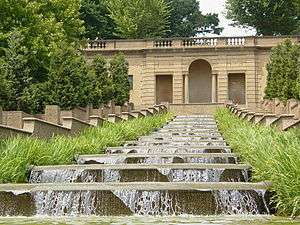Cascading Waterfall
 | |
| Artist | John Joseph Earley |
|---|---|
| Year | 1936 |
| Type | Concrete |
| Dimensions | 9,100 cm (3600 in) |
| Location | Washington, D.C. |
| 38°55′11.44″N 77°2′8.38″W / 38.9198444°N 77.0356611°W | |
| Owner | National Park Service |
Cascading Waterfall, is a public artwork by American artist John Joseph Earley, located Meridian Hill Park, which is in Washington, DC, United States. The Cascading Waterfall was originally surveyed as part of the Smithsonian's Save Outdoor Sculpture! survey in 1994. The fountain, reminiscent of 16th century Italian villas, focuses primarily on thirteen large semi-circular basins which the waterfall flows over, forming a cascade that overlooks the historic park.
Description
Primarily made of concrete, the water flows from two terrace fountains and reappears in "three columns of water and two shell spills in five niches which are located in the face of terrace retaining wall." After entering the niches, the water moves from two basins and two more spout overflows, and then into a series of thirteen graduated cascade basins that enter into large pools. The large pools feature four grotesque spouting masks, four urn jets, two dolphin sprays, and eight white water jets that help to refresh the water of the pool. The 16th Street side of the fountain has more niches and shell overflows and a recirculation room is in the control room under the great wall. Landscaping and walkways flank the fountain on both sides.[1]
Information
The waterfall, which was completed in 1936, is considered the largest of its kind in North America. The walkways surrounding the waterfall features the first use of aggregated concrete anywhere in the world.[2] The waterfall is maintained by the National Park Service.[1]
Artist
Condition
The waterfall was surveyed in 1994 by Save Outdoor Sculpture and at the time treatment was needed.[1]
External links
References
- 1 2 3 Save Outdoor Sculptures! (1994). "Cascading Waterfall (sculpture)". SOS!. Smithsonian. Retrieved 15 July 2010.
- ↑ Richard E. Miller (2009). "Meridian Hill Park". Greater U Street Heritage Trail. The Historical Market Database. Retrieved 19 July 2010.